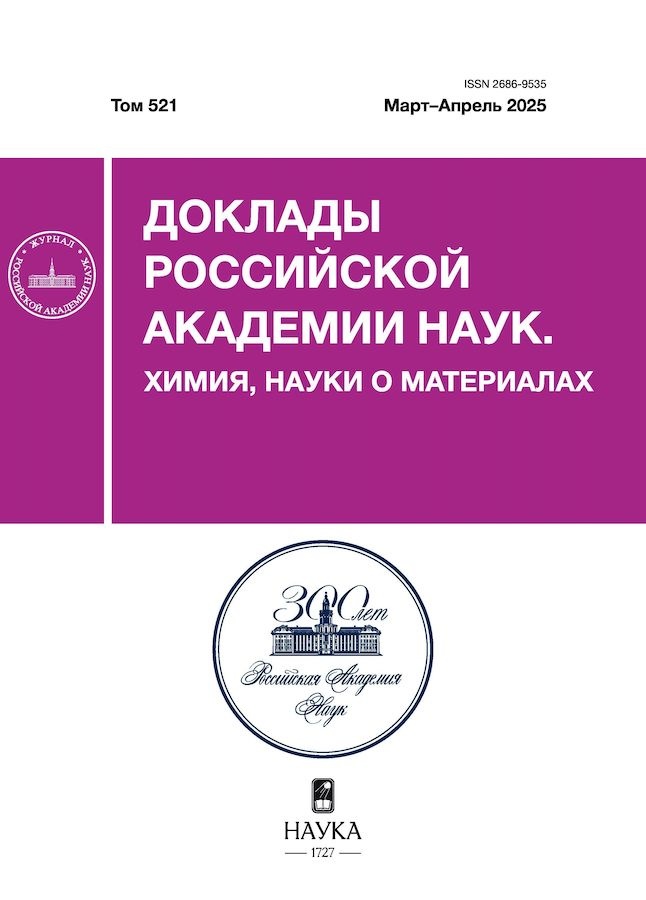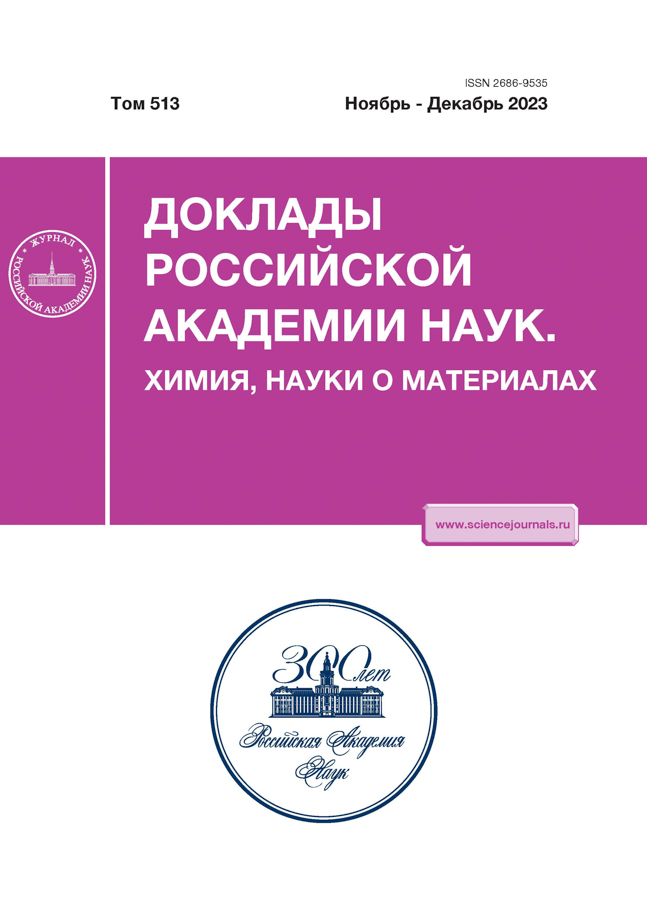Фазообразование в щелочных титаносиликатных системах при гидротермальном синтезе
- Авторы: Герасимова Л.Г.1, Щукина Е.С.1, Маслова М.В.1, Николаев А.И.1
-
Учреждения:
- Институт химии и технологии редких элементов и минерального сырья им. И.В. Тананаева – обособленное подразделение ФИЦ КНЦ Российской академии наук
- Выпуск: Том 513, № 1 (2023)
- Страницы: 86-92
- Раздел: ХИМИЯ
- URL: https://snv63.ru/2686-9535/article/view/651936
- DOI: https://doi.org/10.31857/S2686953523700255
- EDN: https://elibrary.ru/BIUMSJ
- ID: 651936
Цитировать
Полный текст
Аннотация
Проведены исследования в поликомпонентных высоко щелочных системах – TiO2–H2SO4–Na2SiO3–NaOH–H2O и TiO2–H2SO4–(NH4)2SO4–Na2SiO3–NaOH–H2O в условиях гидротермального синтеза, обеспечивающего получение новых продуктов с заданными техническими свойствами. Показано, что посредством направленного подбора структурообразующих компонентов, в частности соединений титана, совместно с оптимальными параметрами гидротермальной обработки полученного прекурсора возможно формирование соединений с заданным химическим составом, размером и морфологией частиц. Установлено, что при синтезе скорость структурных преобразований зависит от фазового состава титаносиликатных прекурсоров. При их гидротермальной обработке протекает щелочной и термический гидролиз с последующей дегидратацией гидролизованных фаз титана (IV) и кремния. Это сопровождается локализацией свободных связей, обеспечивающих образование Ti–O–Si–O-мостиков и их последующую трансформацию в структурированные новообразования.
Об авторах
Л. Г. Герасимова
Институт химии и технологии редких элементови минерального сырья им. И.В. Тананаева – обособленное подразделение ФИЦ КНЦ Российской академии наук
Автор, ответственный за переписку.
Email: l.gerasimova@ksc.ru
Россия, 184209, Мурманская обл., Апатиты
Е. С. Щукина
Институт химии и технологии редких элементови минерального сырья им. И.В. Тананаева – обособленное подразделение ФИЦ КНЦ Российской академии наук
Email: l.gerasimova@ksc.ru
Россия, 184209, Мурманская обл., Апатиты
М. В. Маслова
Институт химии и технологии редких элементови минерального сырья им. И.В. Тананаева – обособленное подразделение ФИЦ КНЦ Российской академии наук
Email: l.gerasimova@ksc.ru
Россия, 184209, Мурманская обл., Апатиты
А. И. Николаев
Институт химии и технологии редких элементови минерального сырья им. И.В. Тананаева – обособленное подразделение ФИЦ КНЦ Российской академии наук
Email: l.gerasimova@ksc.ru
Россия, 184209, Мурманская обл., Апатиты
Список литературы
- Yakovenchuk V.N., Krivovichev S.V., Pakhomovsky Y.A., Selivanova E.A., Ivanyuk G.Y. Microporous titanosilicates of the lintisite-kukisvumite group and their transformation in acidic solutions. In: Minerals as advanced materials II. Krivovichev S.V. (Ed.). Springer, Berlin, Heidelberg, 2012. P. 229–238. https://doi.org/10.1007/978-3-642-20018-2_23
- Folli A., Pochard I., Nonat A., Jakobsen U.H., She-pherd A.M., Macphee D.E. // J. Am. Ceram. Soc. 2010. V. 93 (10). P. 3360–3369. https://doi.org/10.1111/j.1551-2916.2010.03838.x
- Young D.A. Crystalline titano-silicate zeolites. Patent US3329481A. 1967.
- Taramasso M., Perego G., Notari B. Preparation of porous crystalline synthetic material comprised of silicon and titanium oxides. Patent US4410501A. 1983.
- Kuznicki S.M. Large-pored crystalline titanium mole-cular sieve zeolites. Patent US5011591A. 1991.
- Ferraris G., Khomyakov A.P., Belluso E., Soboleva S. Polysomatic relationships in some titanosilicates occurring in the hyperagpaitic alkaline rocks of the Kola Peninsula, Russia. In: Mineralogy. Proc. 30th Int. Geol. Cong., V. 16. Huang Yunhui, Cao Yawen (Ed.). London: CRC Press. 1998. P. 17–27. https://doi.org/10.1201/9781003079569
- Liu L., Tan W., Xiao P., Zhai Y. // Int. J. Miner. Metall. Mater. 2012. V. 19. P. 675–678. https://doi.org/10.1007/s12613-012-0612-4
- Xu H., Zhang Y., Navrotsky A. // Micropor. Mesopor. Mat. 2001. V. 47. P. 285–291. https://doi.org/10.1016/S1387-1811(01)00388-2
- Mann N.R., Todd T.A. // Sep. Sci. Technol. 2005. V. 39. № 10. P. 2351–2371. https://doi.org/10.1081/SS-120039321
- Спиридонова Д.В., Кривовичев С.В., Яковенчук В.Н., Пахомовский Я.А. // ЗРМО. 2010. № 5. С. 79–88.
- Gerasimova L.G., Nikolaev A.I., Shchukina E.S., Mas-lova M.V. // Dokl. Chem. 2020. V. 491. № 1. C. 49–53. https://doi.org/10.1134/S0012500820030039
- Щукина Е.С., Герасимова Л.Г., Маслова М.В. // Фундаментальные исследования. 2018. № 11–1. С. 18–23. https://doi.org/10.17513/fr.42294
- Wei M., Zhang L., Xiong Y., Li J., Peng P. // Microporous Mesoporous Mater. 2016. V. 227. P. 88–94. https://doi.org/10.1016/j.micromeso.2016.02.050
- De Boer J.H., Lippens B.C., Linsen B.G., Broekhoff J.C.P., van den Heuvel A., Osinga Th.J. // J. Colloid Interface Sci. 1966. V. 21. № 4. P. 405–414. https://doi.org/10.1016/0095-8522(66)90006-7
- Neimark A.V., Ravikovitch P.I., Vishnyakov A. // J. Phys. Condens. Matter. 2003. V. 15. № 3. P. 347–367. https://doi.org/10.1088/0953-8984/15/3/303
- Samburov G.O., Kalashnikova G.O., Panikorovskii T.L., Bocharov V.N., Kasikov A., Selivanova E., Bazai A.V., Bernadskaya D., Yakovenchuk V.N., Krivovichev S.V. // Crystals. 2022. V. 12. № 3. P. 311. https://doi.org/10.3390/cryst12030311
- Perovskiy I., Yanicheva N.Yu., Stalyugin V.V., Paniko-rovskii T.L., Golov A.A. // Microporous Mesoporous Mater. 2021. V. 311. P. 110716. https://doi.org/10.1016/j.micromeso.2020.110716
Дополнительные файлы

















